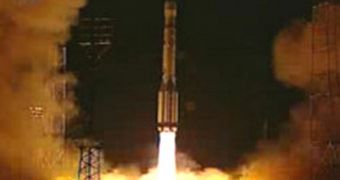The Russian Federation has made no secret from the fact that it plans to construct its own global navigation system, similar to the American Global Positioning System (GPS). In order to do this successfully, and to gain global coverage, the nation's space agency, RosCosmos, needs to deliver a large number of satellites into low-Earth orbit. The process to assemble the network has been running smoothly until now, and the system received three new components yesterday, March 1, as three satellites were launched into space aboard a Proton rocket, Space reports.
The Glonass satellites were launched from the Baikonur Cosmodrome, in Kazakhstan, at around 2119 GMT, or little after midnight, local time. The new orbital additions are expected to improve Russia's ability to provide navigation coordinates, velocity and precise timing information to the individuals using the system. It is not the first country to try and replicate, or even exceed the GPS. The Chinese are also in the middle of constructing their own positioning system, which is scheduled for completion in a few years. It will first provide coverage for mainland China, but it will eventually stretch out to cover the entire world.
The new replenishment satellites were injected into an orbit some 12,000 miles high, at an inclination of about 64.8 degrees, RosCosmos officials say. The total payload weighed in at around 9,000 pounds, with each satellites accounting for about a third, or roughly 1,500 kilograms. The space vehicles were produced by Information Satellite Systems Reshetnev Co. and the company guarantees that the new and improved Glonass M spacecrafts will last for more than seven years in the harshness of space. At this point, Glonass features 18 fully-operational satellites, with two taken out of circulation for maintenance work.
These numbers mean that RosCosmos now has complete coverage of Russian territory. In order to gain global coverage, an additional 6 spacecraft are needed. The Glonass components are placed in three different orbital planes, 1, 2, and 3, each of which is designed to hold up to 8 spacecraft. This maximizes global coverage, but some additions are still needed. The newly-launched satellites were injected into Plane 3. Three additional satellites are scheduled for launch on another Proton rocket this August, officials at the space agency said.

 14 DAY TRIAL //
14 DAY TRIAL //